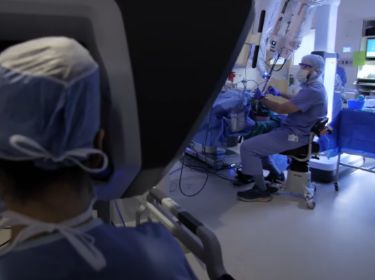Skull base surgery is a highly specialized field that treats tumors and abnormalities at the junction between the brain, skull, and facial structures.
Thanks to advancements within this field, the way in which intricate skull base surgery is performed, is evolving. With an emphasis on precision, minimally invasive approaches and cutting-edge technologies, patient outcomes and quality of life are improving.
At Cleveland Clinic Abu Dhabi, our Skull Base Program team – designated as a North American Skull Base Society (NASBS) Multidisciplinary Team of Distinction – consists of highly skilled otolaryngologists, neurosurgeons and ophthalmologists. With decades of experience, the team offer world-class expertise and the latest surgical treatments to treat even the most complicated of cases.
What is Skull Base Surgery?
Our skull is made up of bones and cartilage, which surround the brain and form our face and cranium. Five bones form the skull base which also form our eye socket, some sinuses, roof of the nasal cavity, and bones surrounding the inner ear. The skull base is a delicate area with openings through which our spinal cord, nerves and many blood vessels pass through.
Skull base surgery is performed to remove cancerous and noncancerous growths, as well as abnormalities under the brain, the top of the spinal column or the skull base.
Traditionally, the only way to perform skull base surgery was to open the skull. Nowadays, due to the intricacy of the area, skull base surgery is usually performed in a minimally invasive endoscopic way, and a surgeon will insert an endoscope through the nose or mouth. Skull base procedures are complex and require a multidisciplinary team of specialists including ENT (ear, nose, and throat) surgeons, neurosurgeons, maxillofacial surgeons, and radiologists.
What are the Benefits of Minimally Invasive Skull Base Surgery?
Advances in technology and the introduction of minimally invasive techniques are offering patients requiring complex skull base surgery a number of benefits. These include:
- Minimally invasive approaches
The emergence of minimally invasive techniques represents one of the most significant developments in skull base surgery. Techniques such as endoscopic endonasal surgery allow surgeons to access the base of the skull through the body’s natural openings, such as the nostrils. This avoids the need for large incisions and minimizes damage to surrounding tissues. As a result, patients undergoing minimally invasive skull base surgery experience shorter recovery times, less postoperative pain and reduced risk of complications compared to traditional open approaches.
- Improved visualization
Endoscopes have evolved and now feature high-definition cameras and microscopes. This has drastically improved visualization for surgeons during skull base surgery, providing them with enhanced clarity and magnification, enabling more accurate surgery and better patient outcomes.
- Improved precision
Thanks to the improved visualization that today’s endoscopes provide, surgeons have a better view of the intricate surgical field which affords greater precision in tumor removal or correction of abnormalities. It also means that surrounding critical structures like nerves and blood vessels are less likely to be damaged, supporting faster recovery and improved surgical outcomes.
- Customized surgical planning
With the integration of advanced imaging techniques, such as MRI and CT scans, surgeons are now able to meticulously plan customized treatment strategies for skull base surgery. Advanced images provide surgeons with detailed insights into each patient's unique anatomy and pathology, allowing them to plan the most effective and least invasive surgical approach tailored to the individual's specific condition. This personalized approach enhances surgical outcomes and minimizes the risk of complications.
- Multidisciplinary collaboration
Skull base surgery often requires a multidisciplinary team approach, involving neurosurgeons, oncologists, otolaryngologists, radiologists and more. By incorporating the expertise of multiple specialists, patients benefit from a holistic approach to their care, addressing all aspects of their condition. Adopting such a collaborative approach to skull base surgery ensures comprehensive care, from diagnosis through to treatment and rehabilitation, improving patient care and outcomes.
- Innovative reconstruction techniques
For patients who have undergone tumor removal or correction of an abnormality, reconstruction of the skull base is vital to protect the brain’s critical structures. Advances in reconstruction techniques, including the use of vascularized flaps and custom-made implants, have significantly enhanced the safety and effectiveness of these procedures. These innovative approaches ensure optimal functional outcomes and minimize the risk of postoperative complications.
- Neuro-navigation and intraoperative imaging
Technological innovations such as intraoperative MRI and computer-assisted navigation systems provide real-time feedback during surgery, enabling more precise tumor resection and reducing the risk of damaging critical brain structures. These technologies represent a significant leap forward in the safety and efficacy of skull base surgeries, facilitating better patient outcomes and minimizing the risk of postoperative complications.
- Improved functional outcomes
Advances in skull base surgery techniques are not only improving treatment outcomes, but they are also preserving or restoring function. By minimizing trauma to critical areas and preserving neurological function, patients experience better postoperative functional outcomes, including preserved senses such as vision and hearing, ultimately enhancing their overall quality of life.
Thanks to a combination of minimally invasive techniques, advanced imaging technologies and multidisciplinary collaboration, patients requiring skull base surgery are benefitting from improved outcomes, enhanced safety, and greater preservation of function.
© Copyright 2024 Cleveland Clinic Abu Dhabi. All rights reserved.
This page has been reviewed by a medical professional from Cleveland Clinic Abu Dhabi. Information on this page is not intended to replace the medical advice of your doctor or health care provider. Please consult your health care provider for advice about a specific medical condition.
Learn more about our editorial process here.

